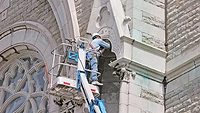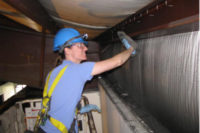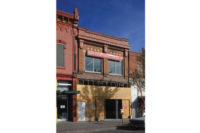Lessons Learned from Restoring a Historic Church After a Fire
Dry Ice Blasting, Asbestos Abatement, Contractor Safety and a Hidden Surprise
Earlier this year, SERVPRO of Southeast Nashville received a call to respond to a historic church after a fire damaged a large portion of its sanctuary. A heater caused the curtains to catch fire, which spread to the walls, damaging drywall, plaster, the stage, roofing tiles and deposited smoke and soot onto the pews, stage and throughout the structure.
Unique Features
The church, which was more than 100 years old, was the oldest structure Production Manager Chase Bisig had personally worked on in his 10 years in the industry. Beautiful stained glass surrounded the sanctuary, some of which was damaged in the fire.
When crews arrived on site, there was more than two feet of drywall, insulation and debris covering the floors that was required to be removed before remediation could begin.
“It was an overwhelming sight for the customers to see,” Bisig said. “The church does a lot of community service, so their main concern was getting the building back up to service patrons as quickly as possible.”
Much of the wood support structure and trim was charred, so it was important to assess the damage, the safety of the structure itself, and to determine what could be salvaged to maintain its historic character.
Challenges
The historic nature of the building presented many challenges, and the customer wanted to preserve as much of the original items and structure as possible, especially the original flooring, the roof system including joists and beams, and the remaining stained-glass windows. Some of the items were more than 120 years old.
“The biggest challenge was cleaning the roof and rafters,” Bisig said. “Because they are so high, we needed to bring in lifts to get up there, and we had to remove joists to get access to the area.”
Rather than cleaning the soot and smoke by dry sponging and wet wiping like a standard fire remediation job, the team decided to use dry ice blasting equipment to expedite the process and more thoroughly clean and deodorize the wood rafters to prepare for encapsulation.
The dry ice medium was a good choice because it doesn’t leave as much mess as soda or sand blasting, Bisig explained.
Due to the age of the building, several other factors presented challenges and concerns.
“Safety is the first and foremost priority, so before we started any of the remediation, we had pros come in and test for asbestos. We also had an engineer inspect the building to determine if the structure required additional support before bringing in crews, if the floor could support the lift equipment, and the integrity of the roofing system,” Bisig said.
Crews worked in full PPE, including suits, full respirators, eye protection and more, and managers held safety briefings daily and performed regular safety check lineups.
Tips from the Job
“When dealing with an older structure, if you aren’t sure, get an expert’s opinion,” Bisig said.
The team relied on the industrial hygienist’s report which determined seven to eight of the 50-plus materials sampled in the building contained asbestos. These required encapsulation and abatement before much of the work could begin.
The report from the engineer verified that while the flooring was older and not built to standard code, it could support the weight of the lift equipment. His report also alerted the team to the integrity of the ceiling joists, which while adequate to support the structure, they should not be used to stand or attach plywood to use as scaffolding for work above the sanctuary.
The process of ice blasting the rafters included positioning the lift, removing a section of joists, cleaning the area they could access, replacing the joist, then repositioning the lift and repeating the process.
While time-consuming, Bisig said the crew of three to four people took about five to seven days to complete.
Another lesson he emphasized was listening to the customer’s needs to create a custom plan for the project.
“While they wanted to preserve as much as possible, they also needed to have some parts of the church operational so they could continue to serve their community. So while waiting for the sanctuary to be cleared for work, we made sure the fellowship center was ready to open so they could host community dinners, open their donation center and still receive guests,” Bisig said.
He also stressed the importance of communication, giving the customer daily updates, even on weekends if no work was being performed, just to ensure them they hadn’t missed anything.
Lessons Learned
Marketing Manager Heather Featherstone met with the customer regularly on site to update them on the progress and reinforce that crews were there to help, no matter what the need.
During the cleanup, she mentioned the beauty of the sanctuary’s original brick and stained glass, to which the customer asked, “What brick?”
Many years ago, church leaders covered the original brick with drywall, and current church members weren’t aware what was behind those walls.
When she showed him the progress, including the 120-year-old brick, he spontaneously pulled out his phone to Facebook Live the moment to his church family, praising the crews, the work being done, and the beautiful surprise hidden behind the walls.
“There’s probably a sermon, or a life lesson, there,” Featherstone said. “The restoration process is not pretty, it’s not easy, and it’s not gentle. There may be some pain. …But when it’s finished, you can be better than before.”
Looking for a reprint of this article?
From high-res PDFs to custom plaques, order your copy today!






